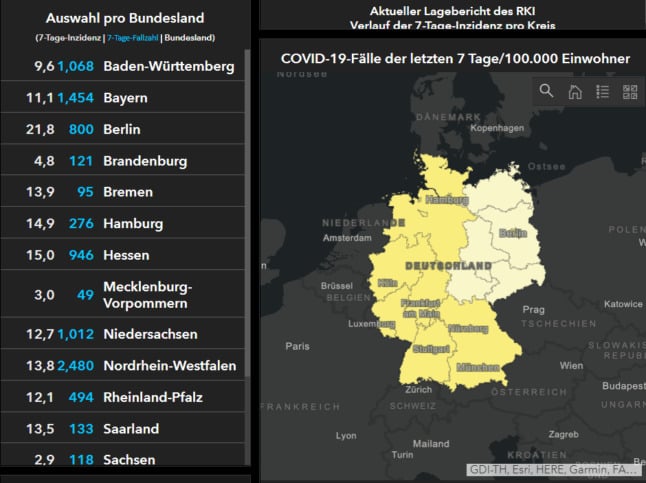As spring turned into summer and pubs, restaurants and tourist attractions reopened for business, many people in Germany believed that that sunny weather would bring with it a momentary respite from the ongoing pandemic.
For a few months, the vaccination rollout had been proceeding apace while infection rates were rapidly dropping. But since the country reached its latest lowest 7-day incidence of 4.9 cases per 100,000 residents on July 6th, the trend appears to have taken a U-turn.
READ ALSO: Is Germany facing a Covid fourth wave fuelled by Delta?
Rise in infections accelerating
As of Wednesday, 11.4 infections per 100,000 people had been recorded in the past week. Though infections have only just slid into double digits nationally, experts are looking with concern at the amount of time it has taken for weekly infections to double.
“The time [the 7-day incidence] takes to double has sunk from 15 to 14 days,” wrote Welt reporter Olaf Gersemann. “If this current trend holds, it will be just under two weeks until the number of active coronavirus infections in Germany doubles [again].”
Verdopplungszeit sinkt von 15 auf 14 Tage:
Hält die aktuelle Dynamik an, würde es nur knapp zwei Wochen dauern, ehe sich die Zahl der aktiven #Corona-Fälle in 🇩🇪 verdoppelt hat.@welt pic.twitter.com/37nn9i2ATq
— Olaf Gersemann (@OlafGersemann) July 20, 2021
This would mean that, by the middle of September, the Covid-19 incidence rate could once again soar into the hundreds.
Health Minister Jens Spahn even warned that should the development continue, the incidence could reach 400 infections per 100,000 people in September – and even 800 cases per 100,000 people in October.
For comparison, on September 17th 2020, the 7-day incidence was 11.5 – which is roughly the same as it was on Wednesday.
In addition, the number of new infections registered within a day rose by 42 percent to more than 2,200, while the average number of daily infections rose by 62 percent to 1,419.
Die Zahl der gemeldeten #Corona-Neuinfektionen steigt weiterhin stark: Der Tageswert von 2203 liegt 42 % höher als vor einer Woche. Der 7-Tage-Mittelwert steigt damit auf 1419, das sind 62 % mehr als vor einer Woche. [1/x] pic.twitter.com/EGmT6xafwn
— Malte Kreutzfeldt (@MKreutzfeldt) July 21, 2021
Where are infections going up?
In the step-by-step reopening of public life, states – who are responsible for setting their own Covid rules – have generally opted for a tiered system linked to 7-day incidence.
When the incidence rises above 35 and stays there for more than three days, state governments are required to tighten restrictions, for instance by limiting the number of people allowed at sports events or private gatherings, or re-introducing testing requirements for indoor gastronomy.
Though the nationwide incidence is currently 11.4, infections aren’t distributed evenly across the country: some districts are registering barely any infections, while other parts of the country have already surpassed the 35 or even the 50 mark.
Here are the districts in Germany where the incidence were highest on July 21st – and where restrictions could be reintroduced just a few weeks after they were scrapped.
- Birkenfeld (Rhineland-Palatinate): 63
- Solingen (North Rhine-Westphalia): 45
- Friedrichshain-Kreuzberg (Berlin): 40.4
- Berlin Mitte (Berlin): 35.2
- Kaiserslautern (Rhineland-Palatinate): 35
- Frankfurt am Main (Hesse): 33.8
- Amberg (Bavaria): 33.1
- Dusseldorf (North-Rhine Westphalia): 33
- Darmstadt (Hesse): 32.5
- Bamberg (Bavaria): 31
- Grafschaft Bentheim (Lower Saxony): 29.9
On a state level, the state with the highest incidence is Berlin, which registered 21.8 new infections per 100,000 people over seven days. The two states with the lowest incidences were Mecklenburg Western-Pomerania and Saxony, with incidences of 2.9 and 3 respectively.

Source: Robert Koch Institute
What rules could change in these areas?
In Rhineland-Palatinate, the district of Birkenfeld – which currently has the highest 7-day incidence of anywhere in Germany, tighter restrictions have already come into force. Outdoor events are now only allowed with up to 500 spectators, while up to 350 are permitted indoors. If the situation remains the same, school pupils will also have to wear masks in classrooms and around the school when they return after the summer break.
READ ALSO: ‘Nobody can rule out enormous fourth wave’: German schools fear new Covid restrictions
In North Rhine-Westphalia, a 7-day incidence of more than 35 puts a district back at stage two of the state’s four-step reopening scheme. At this stage, a number of contact restrictions will once again come into force for sports events and private parties. In addition, tests are needed to dine and drink indoors, while shops and supermarkets must only allow in one person per 10 square metres of space in the establishment.
According to a report in Bild, tighter restrictions could come into force as early as Friday in Solingen.
READ ALSO: ‘Stage zero’: North Rhine-Westphalia to scrap all contact restrictions on Friday
Unlike in North Rhine-Westphalia, Berlin doesn’t have a set of measures that are formally linked to the incidence – though it does keep a close eye on infection rates in order to respond accordingly. On Saturday July 10th, the city-state lifted a number of contact restrictions, while also easing mask-wearing rules and quadrupling the capacity of clubs from 250 to 1,000. If infections continue to rise as rapidly as they have over the past few weeks, there could be another crackdown on the city’s famous nightlife scene.
In Bavaria, things are a little bit simpler, as the state uses an ‘over-50’ or ‘under-50’ barometer to decide on its rules. The district with the highest state, Amberg, currently has a 7-day incidence of 33, so it’s still got some way to go. If infections do pass the 50 mark, however, residents of the state can expect contact restrictions to be reintroduced (up to 10 people from three households), in addition to alternating lessons in schools and widespread testing.

Amberg, in Bavaria, could see its 7-day incidence exceed 50 in the coming weeks. If that happens, it will face further restrictions. Photo: picture alliance/dpa | Armin Weigel
In Hesse, the state’s Covid-19 measures follow a colour-coded system very closely linked to the incidence. An incidence of over 35 is colour-coded orange, and could lead to “an expansion and reinforcement of previous measures.
“In particular, measures to restrict contact and the further closure of facilities and operations connected with the outbreak should be considered,” the state says in its public health guidance.
In the state of Lower Saxony, the regional health ministry also follows a step-by-step plan, with incidences of 35 or more equating to ‘Stage 2’. At this stage, only 10 people from up to three households are allowed to meet socially, and residents of the higher incidence district must wear masks in busy outdoor spaces.
Will it really depend on the number of infections?
While the 7-day incidence figure continues to be the primary means of tracking the spread of Covid and setting restrictions, health experts have expressed the view that tracking infections alone may no longer be enough to decide whether lockdown measures and social contract restrictions are appropriate.
That means that, if hospital admissions and deaths remain low, the country may avoid the type of harsh lockdown it experienced in winter, despite a potential spike in infections.
Furthermore, authorities say they don’t want to enforce harsh restrictions on fully vaccinated people. But it would be tricky – and controversial – to order lockdowns only for unvaccinated people.




 Please whitelist us to continue reading.
Please whitelist us to continue reading.
It is very easy to see numbers to change quickly now that are small.
In a city with 50000 residents, if index is at 10/100000/week, you have 5 new people positive per week.
With just 5 more people (a single family) you will get a 100% increase !